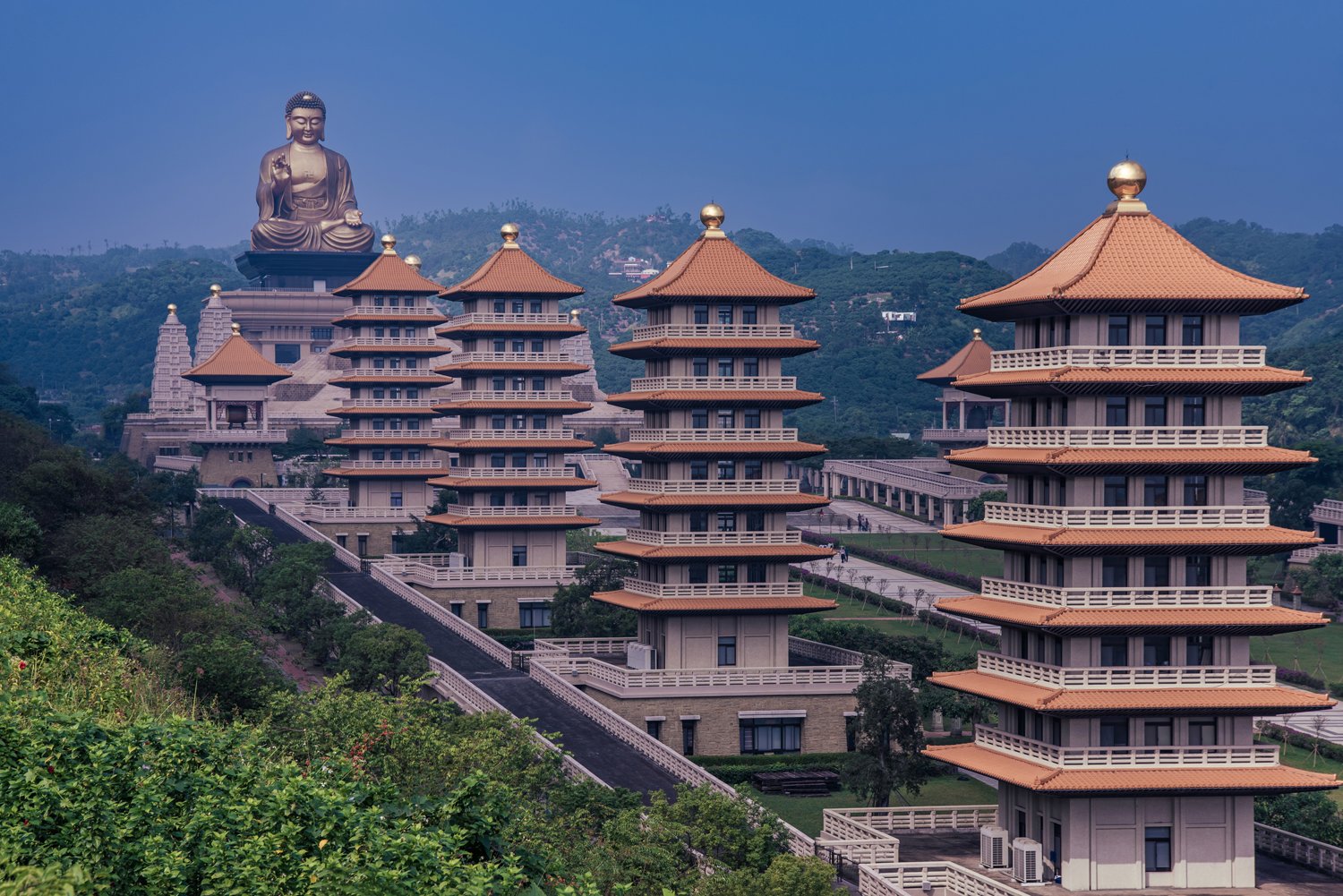Fo Guang Shan, the Magical Buddhist Monastery of Kaohsiung
Monks go on their morning walk on the temple grounds in Fo Guang Shan
Fo Guang Shan is a Buddhist monastery in the mountains of Kaohsiung and one of the most famous monasteries in Taiwan. Both Tourists and Buddhist followers flock to this site, and with good reason. After staying 2 nights in this magical mountain I can happily say that this is one of the most incredible temples I have ever seen. The blend of nature with traditional Buddhist architecture on vast amounts of land means Fo Guang Shan is a truly special monastery.
History
Fo Guang Shan finished construction in 2011 and was built on a massive 100 hectares of land. This means it is the largest Buddhist temple in Taiwan. The temple practices Humanistic Buddhism which focuses on Buddhist rituals in daily life. Its rituals revolve around the living and it encourages Buddhism to create peace for all people of the world. This type of Buddhism dates back thousands of years and is seen as a type of Chinese Buddhism.
The Buddhist statues at the Fo Guang Shan temple
Getting there
Fo Guang Shan is located in Kaohsiung. The Monastery is quite a distance from the city center area and can be reached by bus 8010 from Kaohsiung Station. The bus leaves at 6.20 am, 12.55 pm, and 6.20 pm. This means you will need to plan your journey properly to have enough time to see the monastery. If you miss the bus as we did, then you’ll need to pay a hefty price for a local taxi. It will cost you around 2000 TWD which translated to roughly 65 USD today. Another option is hiring a car which will allow you more flexibility with your visiting times. The journey takes around one hour by bus and is slightly shorter by car.
Buddhist statues set upon trees in the mountains of Fo Guang Shan Temple
Staying in Fo Guang Shan
Staying in Fo Guang Shan for two nights made the experience of the Monastery a whole lot better. The bedroom is small and we got a family type room, between four friends this was quite comfortable for two nights. The beds were single beds but still great for a night’s sleep. Fo Guang Shan stays usually require you to book in advance. Staying in the Buddhist temple allows you to see all the small details like Monks going for their morning walk to pray in the temples. Keep in mind to be respectful of temple rules. Some areas of the monastery might not allow photography. Whilst dressing appropriately by covering your legs and arms will also be required in most areas of the Monastery.
The giant Buddha Statue at night in Fo Guang Shan
The night is also a beautiful sight at the monastery, you can see the statues light up and take a walk around the tranquil temple grounds. The temple stay was free but donations are taken upon checking out. Try to donate, even if it is a small amount as it is important to the temple grounds staying well maintained and the Monastery staying open. The waiting list to book a stay can take a while before you get a room allocated to you. Staying in the monastery is an amazing experience, although it is not absolutely necessary. No booking in advance is needed to visit Fo Guang Shan. So you could just as well go for a day trip, but be sure to get up early and leave the Monastery late so you get to experience the Buddhist rituals throughout the day.
The Eight Pagodas
The Eight Pagodas are traditional Chinese pagodas built on a path leading up to the Buddhist Memorial Museum. This sight was one of my favourites and along with the Buddha Museum, it is the main attraction of Fo Guang Shan. The Eight Pagodas are a great spot for photographers looking to capture the serene Buddhist scenery they imagined before going to Fo Guang Shan. The architecture lights up at night and these Eight Pagoas fit right into the setting leading you up to one of the largest Buddhist statues in the world.
View of the traditional Eight Pagodas and Giant Buddha Statue in Fo Guang Shan
Fo Guang Shan Buddha Museum
Fo Guang Shan Buddha Museum is the main attraction. The museum hosts the largest bronze Buddha statue in the world at 108 meters! This Buddha statue is impressive and the Eight Pagodas leading up to the statue are just as amazing. The traditional Chinese Buddhist architecture perfectly complements the mountain setting of the monastery. Inside the Buddha Museum, you can learn more about the history of the Monastery and the philosophy around Humanist Buddhism.
View of the Giant Buddha Statue in Fo Guang Shan
Food
The monastery has a lot of vegetarian food. It was very well prepared and everything we ate was delicious. For breakfast, you can choose to eat the traditional ceremonial breakfast with the monks if you are interested in this experience. Another option is the western type buffet which is available for travelers who would prefer something more casual. Although I say western type buffet, it is still Chinese food and overall the food experience was excellent during our stay.
Temple Grounds
The temple Grounds are a bit different from the Buddha Museum. Here you will see most of the monks performing their daily rituals and prayers. Be sure to take a look into this area of the Monastery as you will find more of the Buddhist culture and unique characteristics of the Monastery here.
View of a giant Buddhist statue and gardens on the temple grounds of Fo Guang Shan
Fo Guang Shan is a culturally enriching experience. Allowing tourists to gain insight into the lives and daily rituals of Buddhist Monks. This is what makes the temple so unique as not many monasteries are this accessible to tourists. The Buddhist Monastery is easily within reach from Kaohsiung city adding to that accessibility. Whatever your budget is, Fo Guang Shan is a must-see on your journey to Taiwan.








